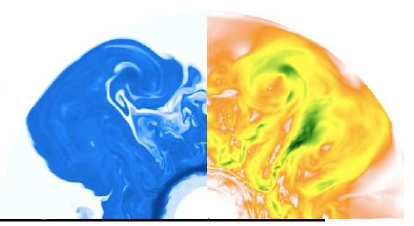Title: Expansion and Age of the Supernova Remnant G350.1-0.3: High-Velocity Iron Ejecta from a Core-Collapse Event
Authors: K.J. Borkowski, W. Miltich, S. P. Reynolds
First author’s institution: Department of Physics, North Carolina State University
Journal: Accepted for publication in Astrophysical Journal Letters. Open access on arXiv.
Disclaimer: The author would first like to publicly state that Black lives and Black Trans lives matter. Secondly, the author condemns all police brutality against people of color. Lastly, the author recognizes that the writing of this article was performed on the stolen land of indigenous people.
Explosive Adolescence
The remnants of violent supernova explosions found in the Milky Way come in all shapes and sizes as they grow and mature. While it is hypothesized that approximately every 10 seconds a star will die somewhere in the universe, it turns out that the explosion of massive stars (aka “core-collapse supernovae”) in the Milky Way is actually quite rare given that none have been observed in the last ~300 years. And so, astronomers who want to get a closer look at how massive stars die must look at the discarded remains of supernovae that occurred in the Milky Way during past millennia. In today’s paper, the authors do just that by analyzing observations of supernova remnant G350.1-0.3 in order to understand its complex, turbulent origins.
Compared to the other young remnants of core-collapse supernovae shown in Figure 1, G350.1-0.3 is somewhat unique: its asymmetric shape and strangely fast velocities make it an atypical addition to the growing collection of known Galactic remnants. Nevertheless, despite its asymmetry, today’s paper revealed special information within G350.1-0.3 that helped to uncover new mysteries of stellar death in the Milky Way.
Worth the Wait
Supernova remnants evolve quite slowly with respect to human timescales. Because of this, the authors had to combine observations of G350.1-0.3 that spanned 9 years (2009-2018) in order to detect changes in its dynamic structure. As plotted in Figure 2, the authors were able to robustly calculate the proper motions of G350.1-0.3, which revealed that the remnant is at most 600 years old. This analysis solidified this imperfect remnant’s place as the third most recent known core-collapse supernova in our galaxy.
Another strange revelation that resulted from long-term X-ray imaging of G350.1-0.3 was that this supernova produced a considerable amount of heavy elements such as Iron. The authors showed that this Iron-rich ejecta is moving quite fast (~5000km/s!) for a remnant of its age. This discovery, combined with its observed asymmetries, indicates that the explosion responsible for G350.1-0.3 was unlike that of normal core-collapse supernovae. This could mean that the massive star progenitor of G350.1-0.3 ejected some of its outer stellar envelope prior to explosion, causing the supernova to be more violent and asymmetric. Overall, these elegant imperfections observed in G350.1-0.3 have emphasized both the complexity of stellar explosions and the need for more in-depth studies of not just typical supernovae but of atypical ones as well.
Edited by: Alex Pizzuto
Featured Image Credit: NASA/Chandra X-ray Observatory




